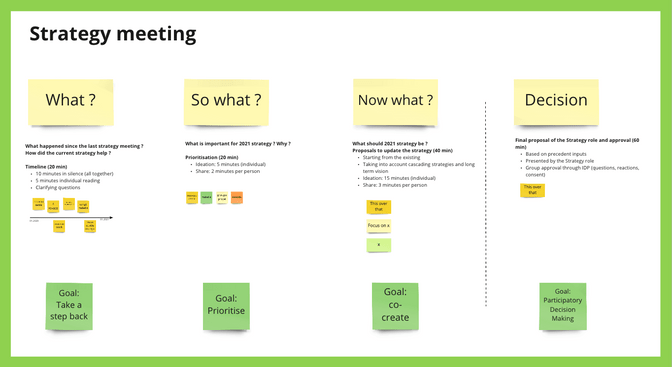Have you heard of la Salamandre? A Swiss-French company of about 20 employees which publishes several books and magazines, including the iconic "Salamandre" magazine, with the laudable mission to "make people love nature".
We’ve been accompanying them on their organizational development path for a year, inspired by F. Laloux's book "Reinventing organizations". They had been using Holacracy for a few years already.
During the preliminary interviews, the "Strategy" role often came up as one of the major themes to evolve on. Too many responsibilities were gathered in this role, and it looked very much like a classical manager position. The Holacracy governance process allowed the role to evolve. What remained to change was the way the strategy was created and decided.
Why change?
Previously, the company's strategy was renewed yearly by Julien and Baptiste, la Salamandre's partners and holders of the Strategy role. The teams then prioritized their projects according to what had been decided.
The general feelings can be summarized in three points:
- A sense of incomprehension and some frustration in the teams regarding the outcome: for some the strategy was too prescriptive; for others on the contrary not enough.
- A feeling of inadequacy between this opaque process, of which only the result was visible, and the desire to move towards more collective intelligence and empowerment of the teams.
- A lot of pressure on Julien and Baptiste's shoulders to come up with "the right strategy".
But above all, they observed that the strategy had been of little guidance in the decisions taken during the year.
A participatory strategy
With the project group responsible for the evolution of the strategy process, we defined a new way of doing things, inspired by the strategy format practised by the Holacracy community, and the what, so what, now what of the Liberating Structures, revised for the occasion.
Here is the process we put in place:

The process, step by step
Prior organization
A "Strategy Contributor" role was created during an extraordinary governance session. Note that this role is explicitly a contributor "only". The final decision will remain within the hands of the existing Strategy role. Each team chose their representative to energize this role.
1st session
Observe. "What?"
In an initial two-hour meeting, participants listed their observations of what was notable in 2020 (the previous year) at la Salamandre. Concrete examples on topics as varied as economic results, occupational health, or the scattering of everyone's focus were brought to everyone's attention.
Make sense. "So what?"
The next question was: of all that has been observed, what is important? Each participant was asked to choose what they thought should be the basis for the new strategy.
Propose. "Now what?"
At the end of this first session, everyone reflected on what should be included in the new strategy and made concrete proposals.
The result of this first session: about ten inputs on what could be included in the 2021 strategy of la Salamandre.
2nd session
Between the two sessions, Julien and Baptiste had time to get a deeper understanding of the proposals and to make choices. This step is essential: the ideation and creative process are collaborative, but they remain responsible for formulating a final proposal.
In this 2nd one-hour session, we used Holacracy's Integrative Decision Making (IDM) process to gain group consent for this new strategy.
The process was the classic IDM process, namely:
- Presentation of the proposal by Julien and Baptiste
- Clarifying questions: understanding before reacting
- Reaction round: everyone reacts to the proposal and makes suggestions for improvement
- Amend and clarify: Julien and Baptiste have the opportunity to make changes to the proposal
- Objection round: everyone agrees to the new proposal, or objects to improve the proposal significantly, if the proposal in its current formulation could harm the team or the company.
The result: a strategy co-created and validated by a representative group of la Salamandre 🎉
Not everything is perfect (or easy)
Everyone hailed this new process as a crucial step towards more collective intelligence. I would also like to point out some less positive feedback:
- The 2nd session was complicated, lots of questions, lots of reactions, too little time. So we had to do a 3rd one-hour session to finalize the process. Note that in the 3rd session, we went through the whole IDM again, based on a new, more succinct and precise proposal.
- The IDM process can be frustrating: it is very participatory, but the proposal remains in the hands of the person who brought it. The bar for objecting is relatively high. Outside of the feedback round, I can't just propose an improvement. But it has the advantage of being result-oriented and allowing the group to move forward.
- The weight on the shoulders of the person who makes the proposal (Julien and Baptiste in this case) remains relatively heavy. They had to accept that they could not please everyone and had to make choices.
For me, apart from the concrete result (a strategy co-created and validated by the group), the enormous added value is the increased competence of the whole group on the theme of strategy. The difficulty to make choices, prioritise, and think for the whole company and not only the part we know best. A nice progression!

